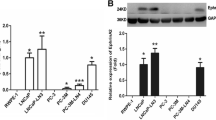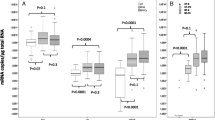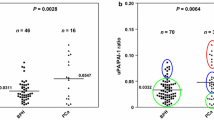Abstract
Altered CD24, c-myc and phospholipase 2a expression was reported in different cancers. Our aim was to measure the expression of these genes in prostate cancer tissues, and compare it to non-cancerous samples. Prostate tissue samples were collected by needle biopsy from 20 prostate cancer (PCA) and 11 benign prostate hyperplasic (BPH) patients. RNA was isolated; cDNA synthetized, CD24, c-myc and phospholipase 2A (PL2A) expressions were determined by quantitative real-time PCR method. The expression of β-globin gene was measured for normalization of the gene expression results. Serum prostate specific antigen (PSA) levels were determined by microparticle enzyme immunoassay (MEIA) method. PSA levels were significantly different between the PCA and BPH groups, 252.37 ± 308.33 ng/ml vs. 3.5 ± 2.14 ng/ml (p = 0.001), respectively. CD24 expression was 988.86 ± 3041 ng/μl in prostate tumor and 4.00 ± 4.25 ng/μl in the BPH group (p = 0.035). The c-myc expression was 88.32 ± 11.93 ng/μl in the prostate tumor and 17.08 ± 21.75 ng/μl in the BPH group (p = 0.02), and the PL2A 31.36 ± 67.02 ng/μl was in PCA and 5.56 ± 14.08 ng/μl in BPH (p = 0.025). Gleason’s scores showed correlation with c-myc (p = 0.019) and PSA (p = 0.033) levels. Overexpression of PL2A, CD24 and c-myc was observed in prostate cancer samples using quantitative real-time PCR method.
Similar content being viewed by others
References
Müller H, Brenner H (2006) Urine markers as possible tools for prostate cancer screening: review of performance characteristics and practicality. Clin Chem 52:562–573
Kopper L, Timár J (2005) Genomics of prostate cancer: is there anything to “translate”. Pathol Oncol Res 11:197–203
Maitland NJ, Collins A (2005) A tumour stem cell hypothesis for the origins of prostate cancer. BJU Int 96:1219–1223
Hughes C, Murphy A, Martin C et al (2005) Molecular pathology of prostate cancer. J Clin Pathol 58:673–684
Quinn DI, Henshall SM, Sutherland LR (2005) Molecular markers of prostate cancer outcome. Eur J Cancer 41:858–887
Glinsky VG, Glinskii BA, Stephenson JA et al (2004) Gene expression profiling predicts clinical outcome of prostate cancer. J Clin Invest 113:913–923
Prowatke I, Devens F, Benner A et al (2006) Expression analysis of imbalanced genes in prostate carcinoma using tissue microarrays. Br J Cancer 96:82–88
Nupponen NN, Kakkola L, Koivisto P et al (1998) Genetic alterations in hormone refractory recurrent prostate carcinomas. Am J Pathol 153:141–148
Kristiansen G, Denkert C, Schlüns K et al (2002) CD24 is expressed in ovarian cancer and is a new independent prognostic marker of patients survival. Am J Pathol 161:1215–1221
Kristiansen G, Schlüns K, Yongwei Y et al (2003) CD24 is an independent prognostic marker of survival in non-small cell lung cancer patients. Br J Cancer 88:231–236
Kristiansen G, Winzer KJ, Mayordomo E et al (2003) CD24 expression is a new prognostic marker in breast cancer. Clin Cancer Res 9:4906–4913
Kristiansen G, Pilarsky C, Pervan J et al (2004) CD24 expression is a significant predictor of PSA relapse and poor prognosis in low grade or organ confined prostate cancer. Prostate 58:183–192
Ponzielli R, Katz S, Barsyte-Lovejoy D et al (2005) Cancer therapeutics: targeting the dark side of Myc. Eur J Cancer 41:2485–2501
Devi RG, Oldenkamp RJ, London AC et al (2002) Inhibition of human chorionic gonadotropin β-subunit modulates the mitogenic effect of c-myc in human prostate cancer cells. Prostate 53:200–210
Hirabayashi T, Shimuzu T (2000) Localization and regulation of cytosolic phospholipase A2. Biochim Biophys Acta 1488:124–138
Dong Q, Patel M, Scott KF et al (2006) Oncogenic action of phospholipase A2 in prostate cancer. Cancer Letters 240:9–16
Wikmam H, Seppanen JK, Sarhadi VK et al (2004) Caveolins as tumor markers in lung cancer detected by combined use of cDNA and tissue microarrays. J Pathol 203:584–593
Kettunen E, Nicholson AG, Nagy B et al (2005) L1CAM, INP10, P-cadherin, tPA and ITGB4 overexpression in malignant pleural mesothelioma primary tumors revealed by combined use of cDNA and tissue microarray. Carcinogenesis 26:17–25
Schostak M, Krause H, Miller K et al (2006) Quantitative real-time RT-PCR of CD24 mRNA in the detection of prostate cancer. BMC Urol 119:1396–1402
Nagy B, Lundan T, Larramendy ML et al (2003) Abnormal expression of apoptosis-related genes in haematological malignancies: overexpression of MYC is poor prognostic sign in mantle cell lymphoma. Br J Haematol 120:434–441
Ohl F, Jung M, Xu C et al (2005) Gene expression studies in prostate cancer tissue: with reference gene should be selected for normalization? J Mol Med 83:1014–1024
Calvo A, Gonzalez-Moreno O et al (2005) Prostate cancer and the genomic revolution: advances using microarray analyses. Mut Res 576:66–79
Raife TJ, Lager DJ, Kemp JD et al (1994) Expression of CD24 (BA-1) predicts monocytic lineage in acute myeloid leukemia. Am J Clin Pathol 101:296–299
Jackson D, Waibel R, Weber E et al (1992) CD24, a signal-transducing molecule expressed on human B cells, is a major surface antigen on small cell lung carcinomas. Cancer Res 52:5264–5270
Huang LR, Hsu HC (1995) Cloning and expression of CD24 gene in human hepatocellular carcinoma: a potential early tumor marker gene correlates with p53 mutation and tumor differentiation. Cancer Res 55:4717–4721
Pirrucello SJ, Lang MS (1990) Differential expression of CD24-related epitopes in mycosis fungiodes/Sezary syndrome: a potential marker for circulating Sezary cells. Blood 76:895–905
Jenkins RB, Qian J, Lieber MM et al (1997) Detection of c-myc oncogene amplification and chromosomal anomalies in metastatic prostatic carcinoma by fluorescence in situ hybridization. Cancer Res 57:524–531
Bernard D, Pourtuer-Manzanedo A, Gil J et al (2003) Myc confers androgen-independent prostate cancer cell growth. J Clin Invest 112:1724–1731
Shachaf CM, Kopelman AM, Arvanitis C et al (2004) MYC inactivation uncovers pluripotent differentiation and tumour dormancy in hepatocellular cancer. Nature 431:1112–1117
Arnold I, Watt FM (2001) c-Myc activation in transgenic mouse epidermis results in mobilization of stem cells and differentiation of their progeny. Curr Biol 11:558–568
Liu YA, Roudier PM, True DL (2004) Heterogeneity in primary and metastatic prostate cancer as defined by cell surface CD profile. Am J Pathol 165:1543–1556
Hughes-Fulford M, Tjandrawinata RR, Li C-F et al (2005) Arachidonic acid, an omega-6 fatty acid, induces cytoplasmic phospholipase A2 in prostate carcinoma cells. Carcinogenesis 26:1520–1526
Kallajoki M, Alanen KA, Nevalainen M et al (1998) Group II phospholipase A2 in human male reproductive organs and genital tumors. Prostate 35:263–272
Shimuzu M, Matsumoto Y, Kurosawa T et al (2008) Release of arachidonic acid induced by tumor necrosis factor-α in the presence of caspase inhibition: evidence for cytosolic phospholipase A2α-independent pathway. Biochem Pharmacol doi:10.1016/j.bcp.2007.11.020
Cummings BS (2007) Phospholipase A2 as targets for anticancer drugs. Biochem Pharmacol 74:949–959
Author information
Authors and Affiliations
Corresponding author
Rights and permissions
About this article
Cite this article
Nagy, B., Szendroi, A. & Romics, I. Overexpression of CD24, c-myc and Phospholipase 2A in Prostate Cancer Tissue Samples Obtained by Needle Biopsy. Pathol. Oncol. Res. 15, 279–283 (2009). https://doi.org/10.1007/s12253-008-9077-1
Received:
Accepted:
Published:
Issue Date:
DOI: https://doi.org/10.1007/s12253-008-9077-1




